

|

|

|

|

|

|

|

|
|
~~~~~~ World Bibliography of Beliefs, Theories and Theologies ~ click pix to enlarge ~~~~~~ Sikh Sikh (meaning: disciple or learner) (English: [sik] or [sk]; Punjabi: , sikkh, IPA: [’sk.k]) is the title and name given to an adherent of Sikhism. The term has its origin in the Sanskrit "shishya", which means disciple or learner. Many male Sikhs can easily be recognized by their turbans, beards, or steel bracelets on their right wrists. The greater Punjab region is the historic homeland of Sikhism. Most Sikhs are from the Punjabi people and now come from the Punjab region of India, although significant communities exist around the world. |
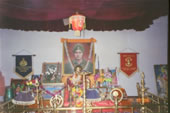
|

|
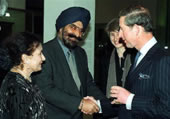
|

|
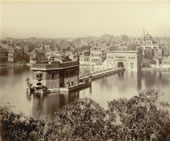
|
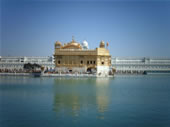
|
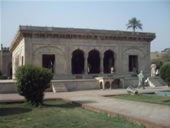
|
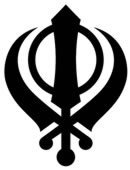
|
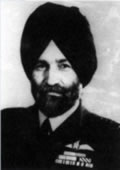
|

|
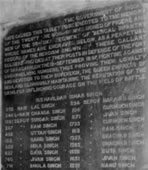
|
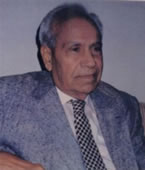
|

|

|

|
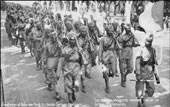
|

|

|
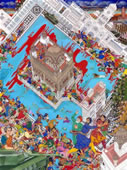
|

|
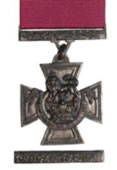
|

|
|
Sikh philosophy The core philosophy and message of the Sikh religion can be understood in the beginning hymn of the holy Guru Granth Sahib, " There is one supreme eternal reality; the truth; immanent in all things; creator of all things; immanent in creation. Without fear and without hatred; not subject to time; beyond birth and death; self-revealing. Known by the Guru’s grace. " Guru Nanak, the founder of the faith, summed up the basis of Sikh lifestyle in three requirements: Naam Japo, Kirat Karni and Wand kay Shako, which means meditate on the holy name, Waheguru, work diligently and honestly and share one’s fruits. The Guru Granth Sahib is revered as a teacher in its own right, because it is a literal transcript of the teachings of the nine gurus. The tenth Guru (Guru Gobind Singh) named Guru Granth Sahib to be the Guru after his death. The Sikh follows the Guru Granth Sahib strictly as his prime guide. It was compiled by the Sikh Gurus, and is maintained in its original form. In addition to their own works the gurus also included the revelations of many saints of that period. Their followers, with their turban and uncut hair, are proud and definitely distinct; yet show respect to the followers of other religions. Non-Sikhs can partake fully in Sikh prayer meetings and social functions. Their daily prayers include the well being of whole mankind. The concept of saint-soldier is another unique feature which sometimes confuses observers. Every Sikh is required to aspire to sainthood by his devotion to God and service to mankind, but also, according to the situation, to adopt the role of the soldier. A Sikh is also commanded, if necessary and circumstances allow, to lay his or her life down to protect the poor and weak, regardless of race, religion, sex or creed. A prime example of this was the martyrdom of the 9th Guru of Sikhism- Guru Teg Bahadur in the protection of the Hindus against religious genocide, in Delhi, on 11 November 1675 AD. Sikhs are not required to renounce the world, and aspire to be the best but not be obsessed by the act, wanting the best but not craving to accumulate. Seva (service) is an integral part of Sikh worship. This is very easily observed in the Gurdwara (temple). Visitors of any religious or socio-economic background are welcomed. Langar (food for all) is always served. The Nishan Sahib, flag of the Sikhs Total population 25,000,000 (25 million) Regions with significant populations India 19,215,730 Other significant population centers: Canada 415,150 United Kingdom 336,179 United States 210,000 East African Community 100,000 Malaysia 100,000 Middle East 85,000 Italy 70,000 Thailand 70,000 Australia 50,000 Hong Kong 7,500 Bangladesh 23,300 Pakistan 20,000 Kuwait 20,000 France 10,000 Singapore 9,733 New Zealand 9,507 Belgium 5,000-6,000 Nepal 5,890 Germany 5,000 Greece 5,000 Fiji 4,674 Austria 2,794 Afghanistan 2,000 Japan 2,000 Ireland 1,200 Language(s) Spoken & written script of holy Guru Granth Sahib: Written language of the Sri Guru Granth Sahib is: Gurmukhi, Sahiskriti and Sant Bhasha Spoken words: Punjabi, Bengali, Brij Bhasha and Persian Predominant spoken languages: Sikh Gurus Guru Nanak Dev Guru Angad Dev Guru Amar Das Guru Ram Das: (Began the construction of Golden Temple). Guru Arjan Dev: (Writer and compiler of the Adi Granth) Guru Har Gobind: (Carrier of Miri and Piri) Guru Har Rai Guru Har Krishan Guru Teg Bahadur Guru Gobind Singh Guru Granth Sahib Saints and other people revered by Sikhs: Bhai Mardana: (One of the first followers and lifelong companion of Guru Nanak) Bhai Bala:(One of the first followers and lifelong companion of Guru Nanak) Bhagat Kabir: (Sikh saint & his masterwork in Guru Granth Sahib) Bhagat Farid: (Sikh saint & his masterwork in Guru Granth Sahib) Bhagat Namdev: (Sikh saint & his masterwork in Guru Granth Sahib) Baba Buddha: (Sikh saint, held the position of high Granthi in the Sikh religion) Baba Banda Singh Bahadur: (Fought and Defeated Mughal Governor of Punjab Wazir Khan and established Sikh force in Punjab) Baba Deep Singh: (Sikh saint, defended Golden Temple with his head in his hand) Bhagat Ravidas(Sikh saint & his masterwork in Guru Granth Sahib) Bhagat Tirlochan(Sikh saint & his masterwork in Guru Granth Sahib) Bhai Mani Singh(Sikh Scholar, compiled the Dasam Granth) Bhai Taru Singh (Was a great patron of the poor) Bhai Gurdas (Known for his interpretation of bani) Sikh Scholars: Bhai Vir Singh Bhai Kahn Singh Nabha Kanga, Kara and Kirpan - three of the five articles of faith endowed to the Sikhs.There are two types of Sikh, a Khalsa Sikh (baptized) and Sahajdhari Sikh (non-baptized), the Five Ks only applies to a (baptized) Khalsa Sikh. The Five Ks, or panj kakaar/kakke, are five items of faith that all baptized Sikhs (Khalsa) are required to wear at all times (but does not apply to non-baptized Sikhs - Sahajdhari Sikhs), at the command of the tenth Sikh Guru, Guru Gobind Singh who so ordered at the Baisakhi Amrit Sanskar in 1699. They are:- Kesh (uncut hair) Kanga (wooden comb) Kaccha (specially-designed underwear) Kara (Iron bracelet) Kirpan (strapped sword). They are for identification and representation of the ideals of Sikhism, such as honesty, equality, fidelity, meditating on God, and never bowing to tyranny. Distribution Chart showing India’s total Sikh population and their percentage of the total Indian population.Numbering approximately 23 million worldwide, Sikhs make up 0.39% of the world population of which approximately 83% live in India. Of the Indian Sikh community 14.6 million, i.e. 76% of all Indian Sikhs, live in the northern Indian State of Punjab (India), where they form a majority 59.9% of the population. Substantial communities of Sikhs, i.e. greater than 200,000, live in the Indian States/Union territories of Haryana, Rajasthan, Uttar Pradesh, Delhi, Maharashtra, Uttaranchal and Jammu and Kashmir. Sikh migration from the then British India began in earnest from the 2nd half of the 19th century when the British had completed their annexation of the Punjab. The British Raj preferentially recruited Sikhs in the Indian Civil Service and, in particular, the British Indian Army, which led to migration of Sikhs to different parts of British India and the British Empire. During the era of the British Raj, semiskilled Sikh artisans were also transported from the Punjab to British East Africa to help in the building of railways. After World War II, Sikhs emigrated from both India and Pakistan, most going to the United Kingdom but many also headed for North America. Some of the Sikhs who had settled in eastern Africa were expelled by Ugandan dictator Idi Amin in 1972. Subsequently the main ’push’ factor for Sikh migration has been economic with significant Sikh communities now being found in Canada, the United Kingdom, the United States, Malaysia, East Africa, Australasia and Thailand. Map showing world Sikh population areas and historical migration patterns (Est. 2004).Whilst the rate of Sikh migration from the Punjab has remained high, traditional patterns of Sikh migration, that favored English speaking countries, particularly the United Kingdom has changed in the past decade due to factors such as stricter immigration procedures. Moliner(2006) states that as a consequence of the ’fact’ that Sikh migration to the UK had "become virtually impossible since the late 1970s", Sikh migration patterns altered to continental Europe. Italy has now emerged as a fast growing area for Sikh migration, with Reggio Emilia and the Vicenza province being areas of significant Sikh population clusters. The Italian Sikhs are generally involved in areas of agriculture, agro-processing, machine tools and horticulture. Due primarily to socio-economic reasons, Indian Sikhs have the lowest adjusted decadal growth rate of any major religious group in India, at 16.9% per decade (est. 1991-2001). Johnson and Barrett(2004) estimate that the global Sikh population increases annually by 392,633 Sikhs, i.e. by 1.7% p.a. on 2004 figures, this growth rate takes into account factors such as births, deaths and conversions. Representation Prime Minister Manmohan Singh shakes hands with U.S. Vice President Dick Cheney after delivering a speech to the Joint session of the United States Congress as Speaker of the House Dennis Hastert looks on.Sikhs are represented in Indian politics, with the current Indian Prime Minister Manmohan Singh, and the Deputy Chairman of the Indian Planning Commission Montek Singh Ahluwalia, all hailing from the community. The current Chief-minister of Punjab is a Sikh Parkash Singh Badal. Past Indian Sikh politicians have included Dr. Gurdial Singh Dhillon, Speaker of the Parliament of India. Pratap Singh Kairon, Union minister, famous Sikh Indian independence movement leader and former Chief-minister of Punjab (India). Prominent politicians of the Sikh Diaspora include the first Asian American to be elected as a full voting Member of United States Congress Dalip Singh Saund, the former mayoress of Dunedin Sukhi Turner, the current UK Parliamentary Under Secretary of State Parmjit Dhanda MP and the Canadian Shadow Social Development Minister Ruby Dhalla MP. Vic Dhillon, is a famous Sikh Canadian politician and current member of the Legislative Assembly of Ontario. Sikhs make up 10-15% of all ranks in the Indian Army and 20% of its officers, whilst Sikhs only forming 1.87% of the Indian population, which makes them over 10 times more likely to be a solider and officer in the Indian Army than the average Indian. Indeed, most Sikh men in India are commonly referred to with the title of Sardar, which means commander in Persian and is a sign of military authority. Photo of Marshal of the Air Force of India Arjan SinghThe Sikh Regiment is the highest decorated regiment of the Indian Army, with 73 Battle Honours, 14 Victoria Crosses, 21 first class Indian Order of Merit (equivalent to the Victoria Cross), 15 Theatre Honours and 5 COAS Unit Citations besides 2 Param Vir Chakras, 14 Maha Vir Chakras, 5 Kirti Chakras, 67 Vir Chakras and 1596 other gallantry awards. The Sikh Regiment Battle InsigniaThe current highest ranking General of the Indian Army is a Sikh General Joginder Jaswant Singh and the highest-ranking General in the history of the Indian Air Force is a Sikh Marshal of the Air Force Arjan Singh. Advanced plans by the MOD to raise an Infantry UK Sikh Regiment were scrapped in June 2007 to the disappointment of the UK Sikh community and Prince Charles of Britain. Historically, most Indians have been farmers and even today (two-thirds) 66% of Indians are farmers. Indian Sikhs are no different and have been predominately employed in the agro-business, India’s 2001 census found that 39% of the working population of Punjab were employed in this sector (less than the Indian average). The success, in the 1960s, of the Green Revolution, in which India went from "famine to plenty, from humiliation to dignity", was based in the Sikh majority state of Punjab which became known as "the breadbasket of India". The Sikh majority state of Punjab is also statistically the wealthiest (per capita) with the average Punjabi through, his hard work, enjoying the highest income in India, 3 times the national Indian average. The Green Revolution centered upon Indian Punjabi Sikh farmers adapting their farming methods to more intensive and mechanized techniques; note this was aided by the electrification of Punjab, cooperative credit, consolidation of small holdings and the existing British Raj developed canal system. Swedish political scientist, Ishtiaq Ahmad, states that a factor in the success of the Indian green revolution transformation was the "Sikh peasant cultivator, often the Jat, whose courage, perseverance, spirit of enterprise and muscle prowess proved crucial". However not all aspects of the green revolution were beneficial, Shiva argues that the green revolution essentially rendered the "negative and destructive impacts of science [i.e. the green revolution] on nature and society" invisible; thus having being separated from their material and political roots in the science system, when new forms of scarcity and social conflict arose they were linked not to traditional causes but to other social systems e.g. religion. Hence Vandana Shiva argues that the green revolution was a catalyst for communal Sikh and Hindu tensions; despite the growth in material affluence. Photo of Professor Piara Singh Gill one of the chief nuclear scientists that worked on the Manhattan project.Sikhs feature in varied professions such as scientists, engineers and doctors; notable Sikhs include nuclear scientist Professor Piara Singh Gill who worked on the Manhattan project; optics scientist ("the father of fibre optics") Dr. Narinder Singh Kapany; physicist and science writer/broadcaster Simon Singh and agricultural scientist Professor Baldev Singh Dhillon. In the sphere of business, the clothing retailers/brands of UK based New Look and Thai based JASPAL were started by Sikhs. India’s largest pharmaceutical company Ranbaxy Laboratories is headed by Sikhs. UK Sikhs have the highest percentage of home ownership, at 82%, out of all UK religious/ethnic communities. In Singapore, Kartar Singh Thakral has built up his family’s trading business, Thakral Holdings/Corp, into a commercial concern with total assets of close to $1.4 billion. Thakral is Singapore’s 25th richest person. Bob Singh Dhillon is the first Indo-Canadian Billionaire and a Sikh. Perhaps no Sikh diaspora group has had as much success as that of those who migrated to North America. In particular the Sikhs who migrated to California’s fertile Central Valley. Armed with only "their farming skills, their willingness to work, and their drive to get ahead" these Sikhs "ensured their rise in status from humble migrant laborers who picked fruit in the hot sun to significant landowners who today control much of the agriculture in California". Today American Sikh agriculturists such as Harbhajan Singh Samra and Didar Singh Bains dominate Californian agriculture and are known colloquially as the "Okra" and "Peach" kings respectively. Prominent Sikh intellectuals, sportsmen and artists include the veteran writer Khushwant Singh, England cricketer Monty Panesar, former 400 m world record holder Milkha Singh, actress Parminder Nagra and Harbhajan Singh India’s most successful off spin Cricket bowler. The Sikhs have migrated to most parts of the world and their vocations are as varied as their appearances. The Sikh community of the Sub-Continent comprises many diverse sets of peoples as the Sikh Gurus preached for ethnic and social harmony. These include different ethnic peoples, tribal and socio-economic groups. Main groupings (i.e. over 1,000 members) include: Arain, Arora, Bairagi, Bania, Basith, Bawaria, Bazigar, Bhabra, Brahman, Chamar, Chhimba, Darzi, Dhobi, Gujar, Jatt, Jhinwar, Kahar, Kamboj, Khatri, Kumhar, Labana, Lohar, Mahtam, Mazhabi, Megh, Mirasi, Mochi, Nai, Rajput, Ramgharia, Saini, Sarera, Sikligar, Sonar, Sudh, Tarkhan and Zargar. In India, the Jatt ethnic grouping is by far the largest at a population of 11,855,000 followed by the Mazhabi at 2,701,000 with the Tarkhans totaling 1,091,000. There has also emerged a specialized group of Sikhs calling themselves Akalis, which have existed since Maharaja Ranjit Singh’s time. Under their leader General Akali Phula Singh, in the early 1800s, they won many battles for the Sikh Empire. History A Sikh Empire warrior’s battle helmetEssentially Sikh history, with respect to Sikhs as a distinct political body, can be said to have began with the martyrdom of the fifth Sikh Guru, Guru Arjan Dev in 1606, Sikh distinction was further enhanced by the establishment of the Sikh ’Pure’ brotherhood or Khalsa (), by Guru Gobind Singh in 1699. This gives the Sikhs, as an organized political grouping, a history of around 400 years. Generally Sikhs have had amicable relations with other religious communities. However, during the Islamic conquest of India (1556-1707), prominent Sikh Gurus were martyred by the ruling Mughals for opposing the Mughul’s persecution of non-Islamic religious communities. Subsequently, the Sikhs militarized to oppose Islamic hegemony. Nevertheless the emergence of the Sikh Empire under reign of the Sikh Maharajah Ranjit Singh was characterized by religious tolerance and pluralism with Christians, Muslims and Hindus in positions of power. The establishment of the Sikh Empire is commonly considered the zenith of Sikh political sovereignty, during this time the Sikh Empire came to include Kashmir, Ladakh, and Peshawar. The Empire’s secular administration integrated innovative military, economic and governmental reforms heavily influenced by the Napoleonic model. Culturally amongst the achievements of the Empire was the establishment of the Imam Bakhsh Lahori school of painting, the discovery of Gandhara art, and the exploration of the Himalayas. A Sikh Empire war medalThe months leading up to the partition India in 1947, saw heavy conflict in the Punjab between Sikh and Muslim, which saw the effective ethnic cleansing of Sikhs from West Punjab which mirrored a similar ethnic cleansing of Muslims in East Punjab. The 1960s saw growing animosity and rioting between Sikhs and Hindus in India, as the Sikhs agitated for the creation of a Sikh majority state, an undertaking which was promised to the Sikh leader Master Tara Singh by Nehru in return for Sikh political support during the negotiations for Indian Independence. Sikhs obtained the Sikh majority state of Punjab on November 1, 1966. Communal tensions between Sikhs and Hindus arose again in the late 1970s, fueled by Sikh claims of discrimination and marginalization by the Hindu dominated Indian National Congress ruling party and the "dictatorial" tactics adopted the then Indian Prime Minister, Indira Gandhi. Frank argues that Gandhi’s assumption of emergency powers in 1975 resulted in the weakening of the "legitimate and impartial machinery of government" and her increasing "paranoia" of opposing political groups led her to instigate a "despotic policy of playing castes, religions and political groups against each other for political advantage". As a reaction against these actions came the emergence of the Sikh leader Sant Jarnail Singh Bhindranwale who vocalized Sikh sentiment for justice and advocated the creation of a Sikh homeland, Khalistan. This accelerated Punjab into a state of communal violence. Gandhi’s 1984 action to defeat Sant Bhindranwale and desecration of the Golden Temple via Operation Bluestar enraged the Sikhs and ultimately led to Gandhi’s assassination by her Sikh bodyguards. The Golden Temple at nightThis resulted in an explosion of violence against the Sikh community in the anti Sikh Riots which resulted in the massacre of thousands of Sikhs throughout India; Khushwant Singh described the actions as being a Sikh pogram in which he "felt like a refugee in my country. In fact, I felt like a Jew in Nazi Germany". Since 1984, relations between Sikhs and Hindus have reached a rapprochement helped by growing economic prosperity; however in 2002 the claims of the popular right-wing Hindu organization the RSS, that "Sikhs are Hindus" angered Sikh sensibilities. Many Sikhs still are campaigning for justice for victims of the violence and the political and economic needs of the Punjab espoused in the Khalistan movement. In 1996 the Special Rapporteur for the Commission on Human Rights on freedom of religion or belief, Abdelfattah Amor (Tunisia, 1993-2004), visited India in order to compose a report on religious discrimination. In 1997, Amor concluded, "it appears that the situation of the Sikhs in the religious field is satisfactory, but that difficulties are arising in the political (foreign interference, terrorism, etc.), economic (in particular with regard to sharing of water supplies) and even occupational fields. Information received from nongovernment (sic) sources indicates that discrimination does exist in certain sectors of the public administration; examples include the decline in the number of Sikhs in the police force and the absence of Sikhs in personal bodyguard units since the murder of Indira Gandhi." Sikhism in the Western world Due to the turbans Sikhs wear and the relative scarcity of Sikhs, there have been incidents of mistaking Sikhs in Western countries for Middle Eastern men and/or Muslims. This has negatively affected Sikhs living in the west especially with respect to the 9/11 terrorist attack and recent Iraq War conflict. After the September 11, 2001 attacks, some people associated Sikhs with terrorists or members of the Taliban. A few days after the attack Balbir Singh Sodhi, a Sikh man, was gunned down by a person who thought that the victim had ties to Al-Qaeda. CNN suggests that there has been an increase in hate-crimes against Sikh men in the United States and the UK. Sikhism as a faith has never actively sought converts, thus the Sikhs have remained a relatively homogeneous racial group. However, mainly due to the activities of Harbhajan Singh Yogi via his Kundalini Yoga focused 3HO (Happy, Healthy, Holy) Organization, Sikhism has witnessed a moderate growth in non-Indian adherents. In 1998 it was estimated that these 3HO Sikhs, known colloquially as ’gora’ () or ’white’ Sikhs, totaled 7,800 and were mainly centered around Española, New Mexico, and Los Angeles, California. Distinguished Sikhs in the modern era Indian revolutionary Udham Singh aka Ram Mohammed Singh Azad.Arjan Singh- Marshal of the Indian Air Force, former Chief of the Air Force Staff Baldev Singh - Indian independence movement leader Shaheed Bhagat Singh Sandhu-Indian independence movement leader and martyr Fauja Singh - 90 year old Sikh marathon runner Kartar Singh Sarabha Grewal - Indian independence movement leader and martyr General Joginder Jaswant Singh - Indian army Chief of Army Staff Hardeep Singh Kohli - Sikh writer, broadcaster and presenter from Scotland Master Tara Singh - Sikh and Indian independence movement leader Dr. Manmohan Singh- Prime Minister of India and economist Milkha Singh (the flying Sikh) - winner of Padma Shri, former 400 m track record holder, Gold medal (440 yards) at ’58 Commonwealth Games, Gold medal (200 & 400 m) at ’58 Asian Games and Gold medal (200 m) in ’62 Asian Games Dr. Narinder Singh Kapany - optics scientist and philanthropist Professor Piara Singh Gill - nuclear scientist Pratap Singh Kairon - Sikh and Indian independence movement leader Sardul Singh Caveeshar - Indian independence movement leader Shaheed Udham Singh - Indian revolutionary and martyr Sikhs in World War I & II and other wars French postcard depicting the arrival of 15th Sikh Regiment in France during World War I. The post card reads, "Gentlemen of India marching to chasten the German hooligans"By the advent of World War I, Sikhs in the British Indian Army totaled over 100,000; i.e. 20% of the British Indian Army. In the 100 years to 1945, 14 Victoria Crosses were awarded to the Sikhs, a per capita record given the size of the Sikh Regiments. "In the last two world wars 83,005 turban wearing Sikh soldiers were killed and 109,045 were wounded. They all died or were wounded for the freedom of Britain and the world, and during shell fire, with no other protection but the turban, the symbol of their faith." The Sikh Regiment in the Second World War Across the world Sikhs are commemorated in Commonwealth cemeteries. In 2002, the names of all Sikh VC and George Cross winners were commemorated by being inscribed on the pavilion monument of the Memorial Gates on Constitution Hill next to Buckingham palace, London. Lieutenant Colonel Chanan Singh Dhillon (retd), Punjabi Indian World War II hero & Veteran, and president of the ex-services league (Punjab & Chandigarh) was instrumental in campaigning for the memorials building. The Battle of Saragarhi The Battle of Saragarhi, and the Sikh officers and soldiers (British Empire Army) who fought in it, is considered one of the greatest stories of collective bravery in human history. UNESCO has described the Battle of Saragarhi, September 12 1897, as one of eight stories of collective bravery. The contingent of the twenty-one Sikhs from the 36th Sikhs was led by Havildar Ishar Singh, and held off an Afghan attack of 10,000 men. All 21 Sikh soldiers chose to fight to the death instead of surrendering. Tablet commemorating the Battle of Saragarhi, raised by the British Empire.In recognition of their supreme sacrifice, the British Parliament rose to pay them respect, and each one of them was awarded the Indian Order of Merit (equal to Victoria Cross). The battle has been ranked, in the West, as one of very few events in history of such bravery that it has been compared to the Battle of Thermopylae, where a small Greek force faced a large Persian army of Xerxes (480 BC). School children in France are taught about The Battle of Saragarhi, as part of the official education syllabus for heroic valour. Saragarhi Day Saragarhi Day, is a Sikh military commemoration day celebrated on 12 September every year annually to commemorate The Battle of Saragarhi. Sikh military personnel and Sikh non-military people commemorate the battle around the World every year on September 12th. During the First World War, Sikh battalions fought in Egypt, Palestine, Mesopotamia, Gallipoli and France. Six battalions of the Sikh Regiment were raised in the World War II, and served at El Alamein and in Burma, Italy and Iraq, winning 27 battle honours. Decorated Sikhs in the military The prestigious Victoria Cross, awarded for exceptional valour "in the face of the enemy".Bana Singh - awarded the Param Vir Chakra. Captain Ishar Singh - The first Sikh to receive the Victoria Cross. Captain Gurbachan Singh Salaria - awarded Param Vir Chakra. Flying Officer Nirmal Jit Singh Sekhon - awarded Param Vir Chakra (the only officer of the Indian Air Force to be awarded Param Vir Chakra). Gian Singh - awarded the Victoria Cross. Lt. General Jagjit Singh Aurora - supervised the surrender of more than 90,000 Pakistani soldiers in East Pakistan (now Bangladesh) during the 1971 India-Pakistan war. Joginder Singh (Subedar) - awarded Param Vir Chakra. Lieutenant Karamjit Singh Judge - awarded the Victoria Cross. Lance Karam Singh - awarded the Military Medal in World War II and awarded Param Vir Chakra (the second person to receive Param Vir Chakra). Major Havildar Parkash Singh - awarded the Victoria Cross. Nand Singh - awarded the Victoria Cross. View inside the shrine of Baba Harbhajan Singh Baba Harbhajan Singh Main article: Baba Harbhajan Singh Baba Harbhajan Singh - is a spiritually revered Sikh soldier by the Indian Army, like a saint, Indian army officers and soldiers believe he gives them protection in war. Art and culture Harmindar Sahib, circa 1870Sikh art and culture is synonymous with that of the Punjab region. The Punjab itself has been called "India’s melting pot", due to the confluence of invading cultures, such as Greek, Mughal and Persian, that mirrors the confluence of rivers from which the region gets its name. Thus Sikh culture is to a large extent informed by this synthesis of cultures. Sikhism has forged a unique form of architecture which Bhatti describes as being "inspired by Guru Nanak’s creative mysticism" such that Sikh architecture "is a mute harbinger of holistic humanism based on pragmatic spirituality". The ’key-note’ of Sikh architecture is the Gurdwara which is the personification of the "melting pot" of Punjabi cultures, showing both Islamic, Sufi and Hindu influences. The reign of the Sikh Empire was the single biggest catylst in creating a uniquely Sikh form of expression, with Maharajah Ranjit Singh patronising the building of forts, palaces, bungas (residential places), colleges, etc that can be said to be of the Sikh Style. Characteristics of Sikh architecture are gilded fluted domes, cupolas, kiosks and stone lanterns with an ornate balustrade on square roofs. The "jewel in the crown" of the Sikh Style is the Harmindar Sahib. Sikh culture is heavily influenced by militaristic motifs, with Khanda being the most obvious; thus it is no surprise that the majority of Sikh artifacts, independent of the relics of the Gurus, have a military theme. This motif is again evident in the Sikh festivals of Hola Mohalla and Vaisakhi which feature marching and practicing displays of valor respectively. |
©